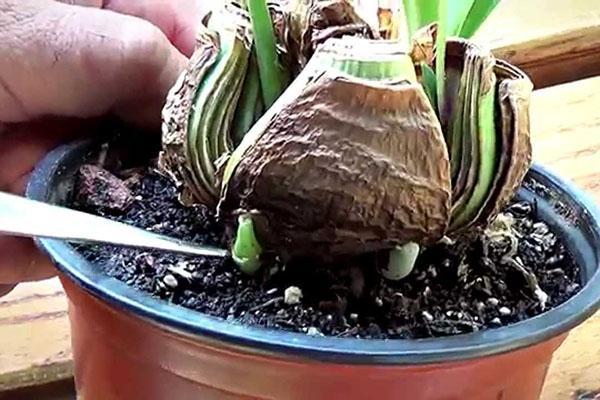The original method of propagation of the hippeastrum by dividing a large bulb
 Hippeastrum is a bulbous plant. Many people grow it at home, like an indoor flower. There are over 200 varieties of hippeastvum. There are pink, red, white and yellow flowers with different patterns. Such a variety of colors makes hippeastrum an excellent decoration for a greenhouse or an open flower garden in the garden. The bulb of this flower is expensive, so gardeners propagate the hippeastrum themselves by dividing the bulb.
Hippeastrum is a bulbous plant. Many people grow it at home, like an indoor flower. There are over 200 varieties of hippeastvum. There are pink, red, white and yellow flowers with different patterns. Such a variety of colors makes hippeastrum an excellent decoration for a greenhouse or an open flower garden in the garden. The bulb of this flower is expensive, so gardeners propagate the hippeastrum themselves by dividing the bulb.
Hippeastrum breeding time
The hippeastrum bulb does not tolerate severe frosts, so it must be dug out for winter storage at home. At this time, the bulb can be propagated. In winter, it will be in a pot, in a warm room, and next spring, hippeastrum can be planted in open ground.
If you propagate the bulb during the winter, it will not have a dormant period and the hippeastrum will not bloom in the first year after planting.
Juvenile bulbs are transplanted into open ground in spring and potash and phosphate fertilizers... In winter, young bulbs are again harvested for storage. In the spring, in the second year, it is advisable to plant them in separate containers so that the bulbs are not susceptible to fungal diseases. In pots, hippeastrum will bloom.
Dividing the hippeastrum bulb
Hippeastrum, like all bulbous plants, is propagated by dividing the mother bulb into parts. In order to get up to 30 juvenile bulbs from one plant, you need:
- remove the top layer of soil to half the bulb;
- remove all peduncles and leaves of the hippeastrum;
- clean the hippeastrum from the top layer of husk, get to the main body of the bulb;
- make a cruciform incision on the bulb with a sharp knife to the ground level;
- insert sticks into the cuts so that the bulb does not grow together, and put the plant on a sunny windowsill;
- take care of the bulb like a regular flower. No special watering or feeding is needed.
Two weeks after the onion is divided into parts, it will be husked again. In another month, it will begin to form children. Up to 30 juvenile bulbs can be obtained from one adult plant, which are separated from the mother flower and planted in open ground in spring as independent plants.
On the mother plant, juvenile bulbs should stay for at least a month. During this time, they will increase in diameter up to 3 cm and will more easily tolerate separation and transplantation. It is better to plant juvenile bulbs in mid-May, when the threat of frost has passed. For better germination, they are treated with a slightly pink solution of potassium permanganate.